Portable cell from Cooma Correctional Museum
The Cooma Correctional Services Museum is one of those fascinating little museums with a big collection.
And central to their collection is not the range of shackles and restraints used to silence and restrict a prisoner, nor the gruesome implements made by inmates for escape and inflicting harm but… the portable cell.
We know Australians are generally fascinated by all things ‘flat-pack’ having had a 20 year affair with Ikea, but this flat-pack fascination extends way back before the Allen key to colonial times when the police ordered and assembled their cells on site.
Now we all know that Australians are generally fascinated by all things ‘flat-pack’ having had a 20 year affair with Ikea, but it seems this flat-pack fascination of ours extends way back before the Allen key to colonial times when the police ordered and assembled their cells on site. Strange, but true.
The portable cell at the Cooma Correctional Museum dates back to the early 1900s and was originally assembled at Malabar Police Station. Made of Australian hardwood, weighing 4 ton complete with solid steel door, these cells arrived in plank form and were constructed in situ. The cells were mainly used in police station as lockups – that’s the holding facility used to detain someone before charging them or before they are remanded in custody. So they’re not gaols as such. The example here at the Cooma museum was restored in 2005 at Long Bay Goal with the help of the inmates – an irony in itself!
Curator Les Strzelecki tells us that in the coming months a new display of the gallows trap door used in executions at Bathurst Gaol will be installed. He’s anticipating much interest in this – he says most people are fascinated with the museum which pitches a contemporary message about crime and punishment using historical objects and stories.
So if you’ve got rowdy kids in the back seat, or someone in your family forensically fascinated and crime crazy, why not stop off and have a look around this little gem of a museum. Just don’t bring your Allen key!




